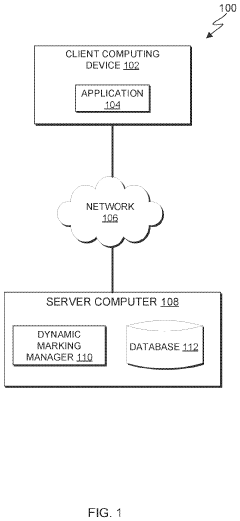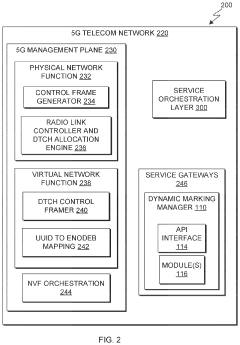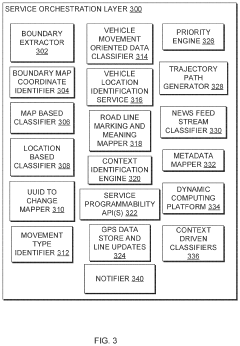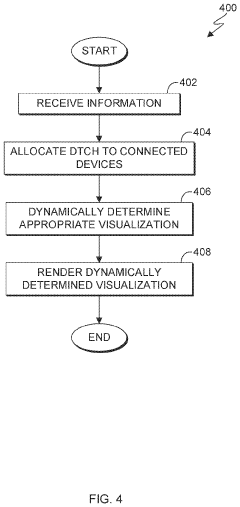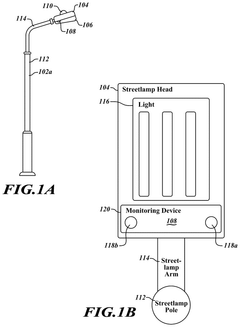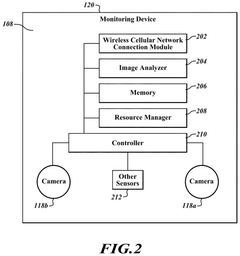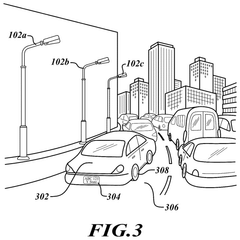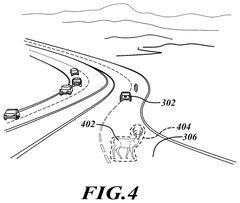How 5G UC Drives Innovation in Smart Traffic Signal Systems
JUL 18, 20259 MIN READ
Generate Your Research Report Instantly with AI Agent
Patsnap Eureka helps you evaluate technical feasibility & market potential.
5G UC in Smart Traffic: Background and Objectives
The integration of 5G Ultra-Capacity (UC) technology into smart traffic signal systems represents a significant leap forward in urban transportation management. This innovative approach aims to revolutionize traffic flow, reduce congestion, and enhance overall road safety. The evolution of traffic signal systems has progressed from simple timed signals to more sophisticated adaptive systems, with 5G UC now poised to take this technology to unprecedented levels of efficiency and responsiveness.
The primary objective of implementing 5G UC in smart traffic signal systems is to create a highly interconnected and intelligent traffic management infrastructure. This technology enables real-time data collection, processing, and communication between vehicles, pedestrians, and traffic signals, allowing for dynamic adjustments to traffic flow based on current conditions. The ultra-low latency and high bandwidth capabilities of 5G UC are crucial in achieving this level of responsiveness and coordination.
Historically, traffic signal systems have been limited by the speed and capacity of communication networks. With the advent of 5G UC, these limitations are significantly reduced, opening up new possibilities for traffic management. The technology aims to minimize travel times, reduce emissions from idling vehicles, and improve the overall quality of urban life by creating smoother, more predictable traffic patterns.
One of the key goals of this technological integration is to support the growing trend of smart cities and autonomous vehicles. By providing a robust communication infrastructure, 5G UC enables traffic signals to interact seamlessly with connected and autonomous vehicles, paving the way for more efficient and safer transportation systems. This aligns with the broader objectives of creating sustainable urban environments and reducing the environmental impact of transportation.
The implementation of 5G UC in smart traffic signal systems also addresses the increasing demand for data-driven decision-making in urban planning and management. By collecting and analyzing vast amounts of real-time traffic data, city planners and traffic engineers can gain valuable insights into traffic patterns, enabling them to make informed decisions about infrastructure improvements and policy changes. This data-centric approach is expected to lead to more effective long-term solutions for urban mobility challenges.
As cities worldwide grapple with growing populations and increasing traffic congestion, the integration of 5G UC into smart traffic signal systems represents a promising solution. The technology is poised to play a crucial role in shaping the future of urban transportation, offering the potential for significant improvements in traffic management, road safety, and overall urban livability.
The primary objective of implementing 5G UC in smart traffic signal systems is to create a highly interconnected and intelligent traffic management infrastructure. This technology enables real-time data collection, processing, and communication between vehicles, pedestrians, and traffic signals, allowing for dynamic adjustments to traffic flow based on current conditions. The ultra-low latency and high bandwidth capabilities of 5G UC are crucial in achieving this level of responsiveness and coordination.
Historically, traffic signal systems have been limited by the speed and capacity of communication networks. With the advent of 5G UC, these limitations are significantly reduced, opening up new possibilities for traffic management. The technology aims to minimize travel times, reduce emissions from idling vehicles, and improve the overall quality of urban life by creating smoother, more predictable traffic patterns.
One of the key goals of this technological integration is to support the growing trend of smart cities and autonomous vehicles. By providing a robust communication infrastructure, 5G UC enables traffic signals to interact seamlessly with connected and autonomous vehicles, paving the way for more efficient and safer transportation systems. This aligns with the broader objectives of creating sustainable urban environments and reducing the environmental impact of transportation.
The implementation of 5G UC in smart traffic signal systems also addresses the increasing demand for data-driven decision-making in urban planning and management. By collecting and analyzing vast amounts of real-time traffic data, city planners and traffic engineers can gain valuable insights into traffic patterns, enabling them to make informed decisions about infrastructure improvements and policy changes. This data-centric approach is expected to lead to more effective long-term solutions for urban mobility challenges.
As cities worldwide grapple with growing populations and increasing traffic congestion, the integration of 5G UC into smart traffic signal systems represents a promising solution. The technology is poised to play a crucial role in shaping the future of urban transportation, offering the potential for significant improvements in traffic management, road safety, and overall urban livability.
Market Demand for Intelligent Transportation Systems
The demand for Intelligent Transportation Systems (ITS) has been steadily growing as urban populations increase and cities face mounting challenges in managing traffic flow, reducing congestion, and improving road safety. Smart traffic signal systems, enhanced by 5G UC technology, are at the forefront of this market demand, offering unprecedented capabilities in real-time traffic management and optimization.
The global ITS market is experiencing significant expansion, driven by the need for more efficient and sustainable urban mobility solutions. According to recent industry reports, the ITS market is projected to reach substantial growth in the coming years, with smart traffic management systems playing a crucial role in this expansion. The integration of 5G UC technology into these systems is expected to accelerate market growth further, as it enables more sophisticated and responsive traffic control mechanisms.
One of the primary drivers of market demand for smart traffic signal systems is the increasing congestion in urban areas. Cities worldwide are grappling with the economic and environmental costs of traffic congestion, which include lost productivity, increased fuel consumption, and higher emissions. Smart traffic signals powered by 5G UC offer a promising solution to these challenges by dynamically adjusting signal timing based on real-time traffic conditions, potentially reducing travel times and improving overall traffic flow.
Another significant factor contributing to the demand for intelligent traffic systems is the growing emphasis on road safety. Smart traffic signals can help reduce accidents by providing more accurate and timely information to drivers and pedestrians. The low latency and high reliability of 5G UC networks enable these systems to react almost instantaneously to changing traffic conditions, potentially preventing collisions and improving safety at intersections.
The push for smart city initiatives across the globe is also fueling the demand for advanced traffic management solutions. Many cities are investing in digital infrastructure to improve urban services, and smart traffic signals are often a key component of these smart city projects. The ability of 5G UC-enabled traffic systems to integrate with other urban systems and IoT devices makes them particularly attractive for comprehensive smart city deployments.
Environmental concerns and the need for sustainable urban development are additional factors driving the adoption of intelligent traffic systems. By optimizing traffic flow and reducing idle times at intersections, smart traffic signals can contribute to lower vehicle emissions and improved air quality in urban areas. This aligns with the sustainability goals of many cities and governments, further boosting market demand for these technologies.
As cities and transportation authorities seek to modernize their infrastructure, the market for 5G UC-driven smart traffic signal systems is expected to see continued growth. The potential for these systems to improve urban mobility, enhance safety, and contribute to environmental sustainability makes them an attractive investment for municipalities and transportation agencies looking to address the complex challenges of modern urban traffic management.
The global ITS market is experiencing significant expansion, driven by the need for more efficient and sustainable urban mobility solutions. According to recent industry reports, the ITS market is projected to reach substantial growth in the coming years, with smart traffic management systems playing a crucial role in this expansion. The integration of 5G UC technology into these systems is expected to accelerate market growth further, as it enables more sophisticated and responsive traffic control mechanisms.
One of the primary drivers of market demand for smart traffic signal systems is the increasing congestion in urban areas. Cities worldwide are grappling with the economic and environmental costs of traffic congestion, which include lost productivity, increased fuel consumption, and higher emissions. Smart traffic signals powered by 5G UC offer a promising solution to these challenges by dynamically adjusting signal timing based on real-time traffic conditions, potentially reducing travel times and improving overall traffic flow.
Another significant factor contributing to the demand for intelligent traffic systems is the growing emphasis on road safety. Smart traffic signals can help reduce accidents by providing more accurate and timely information to drivers and pedestrians. The low latency and high reliability of 5G UC networks enable these systems to react almost instantaneously to changing traffic conditions, potentially preventing collisions and improving safety at intersections.
The push for smart city initiatives across the globe is also fueling the demand for advanced traffic management solutions. Many cities are investing in digital infrastructure to improve urban services, and smart traffic signals are often a key component of these smart city projects. The ability of 5G UC-enabled traffic systems to integrate with other urban systems and IoT devices makes them particularly attractive for comprehensive smart city deployments.
Environmental concerns and the need for sustainable urban development are additional factors driving the adoption of intelligent traffic systems. By optimizing traffic flow and reducing idle times at intersections, smart traffic signals can contribute to lower vehicle emissions and improved air quality in urban areas. This aligns with the sustainability goals of many cities and governments, further boosting market demand for these technologies.
As cities and transportation authorities seek to modernize their infrastructure, the market for 5G UC-driven smart traffic signal systems is expected to see continued growth. The potential for these systems to improve urban mobility, enhance safety, and contribute to environmental sustainability makes them an attractive investment for municipalities and transportation agencies looking to address the complex challenges of modern urban traffic management.
Current 5G UC Technology in Traffic Management
The current state of 5G UC (Ultra-Capacity) technology in traffic management represents a significant leap forward in smart transportation systems. 5G UC networks, characterized by their high bandwidth, low latency, and massive connectivity, are revolutionizing the way traffic signals and management systems operate.
One of the primary applications of 5G UC in traffic management is the implementation of real-time adaptive traffic signal control. These systems utilize a network of sensors and cameras connected via 5G to continuously monitor traffic flow and adjust signal timings accordingly. The ultra-low latency of 5G UC enables near-instantaneous communication between traffic lights and central control systems, allowing for rapid adjustments to changing traffic conditions.
Vehicle-to-Everything (V2X) communication is another key area where 5G UC is making significant strides in traffic management. This technology allows vehicles to communicate with infrastructure, other vehicles, and pedestrians, creating a more connected and safer traffic ecosystem. 5G UC's high bandwidth and low latency are crucial for handling the massive amounts of data generated by V2X systems in real-time.
Edge computing, enabled by 5G UC, is being increasingly deployed in traffic management systems. By processing data closer to its source, edge computing reduces the strain on central servers and further decreases latency. This is particularly beneficial for applications such as real-time traffic prediction and incident detection, where split-second decisions can make a significant difference.
The integration of Artificial Intelligence (AI) and Machine Learning (ML) with 5G UC networks is enhancing predictive capabilities in traffic management. These systems can analyze historical and real-time data to forecast traffic patterns, optimize signal timings, and even predict potential accidents or congestion points before they occur.
5G UC is also facilitating the deployment of high-definition video analytics in traffic management. The increased bandwidth allows for the transmission of high-quality video feeds from multiple cameras, enabling more accurate vehicle detection, license plate recognition, and traffic flow analysis.
In terms of public transportation, 5G UC is improving the accuracy and reliability of bus and train tracking systems. This allows for better scheduling and real-time updates to passengers, enhancing the overall efficiency of public transit networks.
As 5G UC technology continues to evolve, we can expect to see even more advanced applications in traffic management. These may include fully autonomous traffic control systems, seamless integration with smart city infrastructure, and enhanced support for autonomous vehicles. The ongoing development and implementation of 5G UC in traffic management are paving the way for safer, more efficient, and more sustainable urban transportation systems.
One of the primary applications of 5G UC in traffic management is the implementation of real-time adaptive traffic signal control. These systems utilize a network of sensors and cameras connected via 5G to continuously monitor traffic flow and adjust signal timings accordingly. The ultra-low latency of 5G UC enables near-instantaneous communication between traffic lights and central control systems, allowing for rapid adjustments to changing traffic conditions.
Vehicle-to-Everything (V2X) communication is another key area where 5G UC is making significant strides in traffic management. This technology allows vehicles to communicate with infrastructure, other vehicles, and pedestrians, creating a more connected and safer traffic ecosystem. 5G UC's high bandwidth and low latency are crucial for handling the massive amounts of data generated by V2X systems in real-time.
Edge computing, enabled by 5G UC, is being increasingly deployed in traffic management systems. By processing data closer to its source, edge computing reduces the strain on central servers and further decreases latency. This is particularly beneficial for applications such as real-time traffic prediction and incident detection, where split-second decisions can make a significant difference.
The integration of Artificial Intelligence (AI) and Machine Learning (ML) with 5G UC networks is enhancing predictive capabilities in traffic management. These systems can analyze historical and real-time data to forecast traffic patterns, optimize signal timings, and even predict potential accidents or congestion points before they occur.
5G UC is also facilitating the deployment of high-definition video analytics in traffic management. The increased bandwidth allows for the transmission of high-quality video feeds from multiple cameras, enabling more accurate vehicle detection, license plate recognition, and traffic flow analysis.
In terms of public transportation, 5G UC is improving the accuracy and reliability of bus and train tracking systems. This allows for better scheduling and real-time updates to passengers, enhancing the overall efficiency of public transit networks.
As 5G UC technology continues to evolve, we can expect to see even more advanced applications in traffic management. These may include fully autonomous traffic control systems, seamless integration with smart city infrastructure, and enhanced support for autonomous vehicles. The ongoing development and implementation of 5G UC in traffic management are paving the way for safer, more efficient, and more sustainable urban transportation systems.
Existing 5G UC Solutions for Traffic Signals
01 Network capacity enhancement techniques
5G Ultra-Capacity (UC) innovations focus on enhancing network capacity through advanced techniques such as massive MIMO, beamforming, and carrier aggregation. These technologies allow for increased data throughput, improved spectral efficiency, and better coverage in high-density areas.- Network capacity enhancement techniques: 5G Ultra-Capacity (UC) innovations focus on enhancing network capacity through advanced techniques such as massive MIMO, beamforming, and carrier aggregation. These technologies allow for increased data throughput, improved spectral efficiency, and better coverage in high-density areas.
- Dynamic spectrum allocation and management: Innovations in 5G UC include intelligent spectrum allocation and management systems that dynamically assign frequency resources based on real-time demand and network conditions. This approach optimizes spectrum utilization and enhances overall network performance.
- Edge computing integration: 5G UC innovations incorporate edge computing capabilities to reduce latency and improve service quality. By bringing computational resources closer to end-users, these solutions enable faster data processing and support emerging applications such as augmented reality and autonomous vehicles.
- AI-driven network optimization: Artificial intelligence and machine learning algorithms are being integrated into 5G UC networks to optimize performance, predict network congestion, and automate resource allocation. These AI-driven solutions enhance network efficiency and user experience.
- Advanced security protocols: 5G UC innovations include enhanced security measures to protect against cyber threats and ensure data privacy. These protocols incorporate advanced encryption techniques, network slicing for isolated secure channels, and AI-powered threat detection systems.
02 Dynamic spectrum allocation and management
Innovations in 5G UC involve intelligent spectrum allocation and management systems. These systems dynamically allocate frequency resources based on real-time demand, optimize spectrum usage, and enable efficient coexistence with other wireless technologies.Expand Specific Solutions03 Edge computing integration for low latency
5G UC innovations incorporate edge computing capabilities to reduce latency and improve overall network performance. By bringing computing resources closer to the end-users, these solutions enable real-time applications and services that require ultra-low latency.Expand Specific Solutions04 AI-driven network optimization
Artificial intelligence and machine learning algorithms are being integrated into 5G UC networks to optimize performance, predict network congestion, and automate resource allocation. These AI-driven solutions enhance network efficiency and user experience.Expand Specific Solutions05 Advanced security and privacy features
5G UC innovations include enhanced security protocols and privacy-preserving technologies. These features protect user data, prevent unauthorized access, and ensure the integrity of network communications in high-capacity environments.Expand Specific Solutions
Key Players in 5G UC and Smart Traffic Industry
The 5G UC (Ultra Capacity) technology for smart traffic signal systems is in its early growth stage, with significant potential for market expansion. The global market size for intelligent transportation systems is projected to reach $39.5 billion by 2026, with smart traffic management solutions playing a crucial role. While the technology is still evolving, major players like Samsung Electronics, NTT Docomo, LG Electronics, and Qualcomm are actively developing and implementing 5G UC solutions for traffic management. These companies are leveraging their expertise in telecommunications and IoT to create more efficient, responsive, and interconnected traffic signal systems, paving the way for smarter urban mobility.
NTT Docomo, Inc.
Technical Solution: NTT Docomo has developed a 5G-based smart traffic signal system that leverages their expertise in mobile communications and IoT. Their solution utilizes 5G's ultra-reliable low-latency communication (URLLC) capabilities to enable real-time traffic management. The system incorporates a network of sensors, cameras, and edge computing devices to collect and process traffic data at intersections. NTT Docomo's platform employs AI and machine learning algorithms to analyze traffic patterns and optimize signal timing dynamically. Their solution also integrates V2X communication, allowing for direct interaction between vehicles and traffic infrastructure. The system includes features such as adaptive traffic control, priority signaling for public transportation and emergency vehicles, and pedestrian safety enhancements. NTT Docomo's research also explores the use of 5G-enabled drones for traffic monitoring and incident response[10][11].
Strengths: Strong 5G network capabilities, extensive experience in mobile communications, and partnerships with automotive and technology companies. Weaknesses: Limited global presence outside of Japan, potential challenges in adapting to different traffic management regulations in other countries.
QUALCOMM, Inc.
Technical Solution: Qualcomm has developed a comprehensive 5G-based solution for smart traffic signal systems. Their approach integrates 5G Ultra-Wideband (UWB) technology with edge computing to enable real-time traffic management. The system utilizes 5G's low latency and high bandwidth to collect and process data from various sensors and cameras at intersections. Qualcomm's solution employs AI algorithms running on edge devices to analyze traffic patterns and optimize signal timing dynamically. This allows for adaptive traffic control that can respond to changing conditions within milliseconds[1][3]. The system also incorporates vehicle-to-everything (V2X) communication, enabling direct interaction between vehicles and traffic infrastructure, further enhancing safety and efficiency[2].
Strengths: Industry-leading 5G technology, strong AI capabilities, and extensive experience in mobile communications. Weaknesses: Reliance on widespread 5G infrastructure deployment, potential high implementation costs for cities.
Core Innovations in 5G UC for Traffic Control
Generating dynamic electrochromic visualizations
PatentActiveUS20220262243A1
Innovation
- Implementing electrochromic road markings that can change color and opacity based on contextual information detected by sensors and processed through a 5G telecom network's service orchestration layer, allowing dynamic alteration of road markings in real-time.
Vehicle traffic monitoring device systems and methods
PatentPendingUS20240426471A1
Innovation
- Integration of 5G cellular wireless functionality, AI, and computer vision image recognition in connected streetlamps to monitor traffic, detect hazards, and transmit live video feeds and alerts to drivers and authorities via a multi-access edge computing network.
Regulatory Framework for 5G in Urban Infrastructure
The regulatory framework for 5G in urban infrastructure plays a crucial role in shaping the implementation and adoption of smart traffic signal systems. As 5G technology continues to revolutionize urban connectivity, governments and regulatory bodies are developing comprehensive guidelines to ensure its safe and efficient integration into existing infrastructure.
At the federal level, the Federal Communications Commission (FCC) has taken significant steps to facilitate 5G deployment. The FCC has streamlined the approval process for small cell installations, which are essential for 5G networks in urban areas. This includes limiting the fees that local governments can charge for small cell deployments and setting shot clocks for application reviews.
State-level regulations vary, but many states have enacted legislation to accelerate 5G deployment. These laws often preempt local authority over small cell installations, standardize application processes, and cap fees. However, some states have also implemented measures to protect local interests and ensure aesthetic considerations are taken into account.
Local governments play a vital role in the regulatory landscape, as they are responsible for managing public rights-of-way where much of the 5G infrastructure is installed. Many cities have developed specific ordinances and guidelines for 5G deployments, addressing issues such as equipment design, location selection, and maintenance requirements.
The regulatory framework also addresses critical aspects of cybersecurity and data privacy. As smart traffic signal systems rely on the collection and transmission of vast amounts of data, regulations ensure that appropriate safeguards are in place to protect sensitive information and prevent unauthorized access.
Environmental considerations are another key component of the regulatory framework. Regulations often require environmental impact assessments for 5G installations, particularly in sensitive urban areas. This includes evaluating potential effects on wildlife, vegetation, and human health.
Interoperability standards are being developed to ensure that 5G-enabled smart traffic signal systems can communicate effectively across different platforms and jurisdictions. These standards are crucial for creating a seamless, interconnected urban traffic management ecosystem.
As the technology evolves, regulatory bodies are adopting adaptive approaches to keep pace with innovation. This includes establishing sandboxes for testing new 5G applications in traffic management and creating flexible regulatory frameworks that can accommodate emerging technologies and use cases.
At the federal level, the Federal Communications Commission (FCC) has taken significant steps to facilitate 5G deployment. The FCC has streamlined the approval process for small cell installations, which are essential for 5G networks in urban areas. This includes limiting the fees that local governments can charge for small cell deployments and setting shot clocks for application reviews.
State-level regulations vary, but many states have enacted legislation to accelerate 5G deployment. These laws often preempt local authority over small cell installations, standardize application processes, and cap fees. However, some states have also implemented measures to protect local interests and ensure aesthetic considerations are taken into account.
Local governments play a vital role in the regulatory landscape, as they are responsible for managing public rights-of-way where much of the 5G infrastructure is installed. Many cities have developed specific ordinances and guidelines for 5G deployments, addressing issues such as equipment design, location selection, and maintenance requirements.
The regulatory framework also addresses critical aspects of cybersecurity and data privacy. As smart traffic signal systems rely on the collection and transmission of vast amounts of data, regulations ensure that appropriate safeguards are in place to protect sensitive information and prevent unauthorized access.
Environmental considerations are another key component of the regulatory framework. Regulations often require environmental impact assessments for 5G installations, particularly in sensitive urban areas. This includes evaluating potential effects on wildlife, vegetation, and human health.
Interoperability standards are being developed to ensure that 5G-enabled smart traffic signal systems can communicate effectively across different platforms and jurisdictions. These standards are crucial for creating a seamless, interconnected urban traffic management ecosystem.
As the technology evolves, regulatory bodies are adopting adaptive approaches to keep pace with innovation. This includes establishing sandboxes for testing new 5G applications in traffic management and creating flexible regulatory frameworks that can accommodate emerging technologies and use cases.
Environmental Impact of 5G-Enabled Traffic Management
The integration of 5G technology into smart traffic signal systems has the potential to significantly reduce the environmental impact of urban transportation. By enabling real-time data collection and analysis, 5G-powered traffic management systems can optimize traffic flow, reduce congestion, and minimize vehicle emissions.
One of the primary environmental benefits of 5G-enabled traffic management is the reduction of greenhouse gas emissions. Smart traffic signals can adjust their timing based on real-time traffic conditions, reducing unnecessary idling and stop-and-go traffic. This optimization can lead to a substantial decrease in fuel consumption and, consequently, lower carbon dioxide emissions from vehicles.
Air quality improvements are another notable environmental advantage of 5G-powered traffic systems. By reducing congestion and promoting smoother traffic flow, these systems can help decrease the concentration of harmful pollutants such as nitrogen oxides and particulate matter in urban areas. This is particularly crucial in densely populated cities where air pollution poses significant health risks to residents.
The enhanced connectivity provided by 5G also enables more efficient public transportation systems. Real-time data on bus and train locations, coupled with smart traffic signal prioritization, can make public transit more reliable and attractive to commuters. This shift towards public transportation can further reduce the number of private vehicles on the road, leading to additional environmental benefits.
Furthermore, 5G-enabled traffic management systems can contribute to noise pollution reduction in urban environments. By optimizing traffic flow and reducing sudden accelerations and decelerations, these systems can help lower the overall noise levels produced by vehicles, particularly in residential areas and near schools and hospitals.
The implementation of 5G technology in traffic management also supports the adoption of electric and autonomous vehicles. These vehicles rely heavily on connectivity for optimal performance, and 5G networks can provide the necessary infrastructure for their widespread integration. As more electric vehicles enter the roads, supported by efficient traffic management systems, cities can expect a further reduction in emissions and improved air quality.
Lastly, 5G-powered traffic systems can contribute to urban greening initiatives. By reducing the space required for roads and parking through improved traffic efficiency, cities can potentially repurpose some areas for green spaces, parks, or pedestrian zones. This not only enhances the urban environment but also contributes to carbon sequestration and improved biodiversity in city centers.
One of the primary environmental benefits of 5G-enabled traffic management is the reduction of greenhouse gas emissions. Smart traffic signals can adjust their timing based on real-time traffic conditions, reducing unnecessary idling and stop-and-go traffic. This optimization can lead to a substantial decrease in fuel consumption and, consequently, lower carbon dioxide emissions from vehicles.
Air quality improvements are another notable environmental advantage of 5G-powered traffic systems. By reducing congestion and promoting smoother traffic flow, these systems can help decrease the concentration of harmful pollutants such as nitrogen oxides and particulate matter in urban areas. This is particularly crucial in densely populated cities where air pollution poses significant health risks to residents.
The enhanced connectivity provided by 5G also enables more efficient public transportation systems. Real-time data on bus and train locations, coupled with smart traffic signal prioritization, can make public transit more reliable and attractive to commuters. This shift towards public transportation can further reduce the number of private vehicles on the road, leading to additional environmental benefits.
Furthermore, 5G-enabled traffic management systems can contribute to noise pollution reduction in urban environments. By optimizing traffic flow and reducing sudden accelerations and decelerations, these systems can help lower the overall noise levels produced by vehicles, particularly in residential areas and near schools and hospitals.
The implementation of 5G technology in traffic management also supports the adoption of electric and autonomous vehicles. These vehicles rely heavily on connectivity for optimal performance, and 5G networks can provide the necessary infrastructure for their widespread integration. As more electric vehicles enter the roads, supported by efficient traffic management systems, cities can expect a further reduction in emissions and improved air quality.
Lastly, 5G-powered traffic systems can contribute to urban greening initiatives. By reducing the space required for roads and parking through improved traffic efficiency, cities can potentially repurpose some areas for green spaces, parks, or pedestrian zones. This not only enhances the urban environment but also contributes to carbon sequestration and improved biodiversity in city centers.
Unlock deeper insights with Patsnap Eureka Quick Research — get a full tech report to explore trends and direct your research. Try now!
Generate Your Research Report Instantly with AI Agent
Supercharge your innovation with Patsnap Eureka AI Agent Platform!
